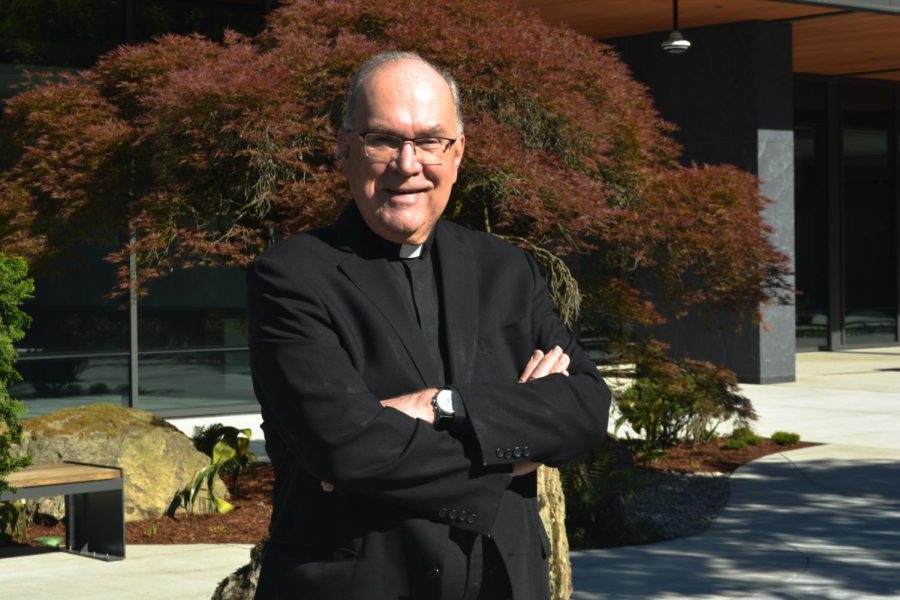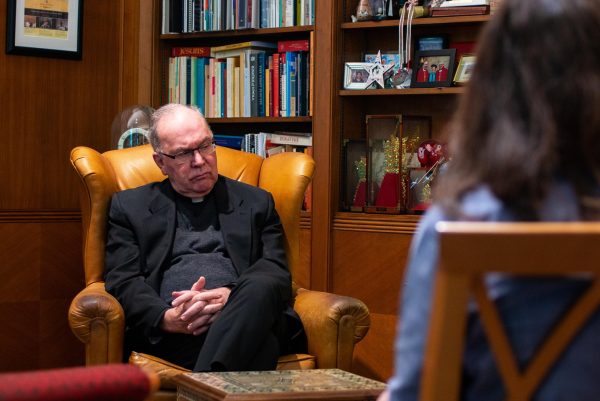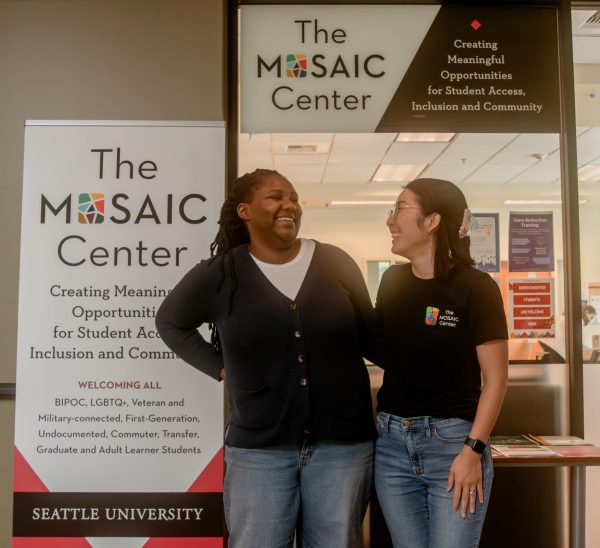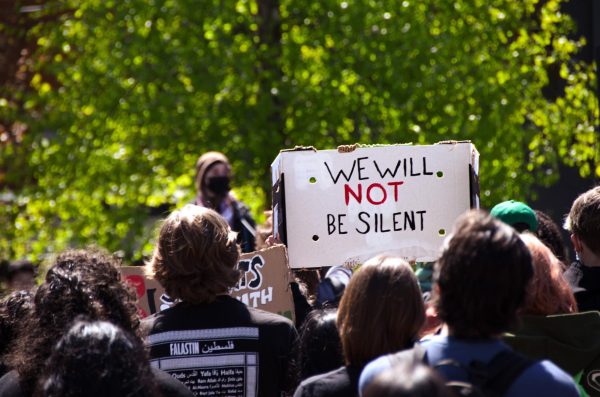Twenty-Four Year Term of Seattle U President Stephen V. Sundborg, S.J. Coming to an End
Stephen V. Sundborg, S.J. featured in front of the Center for Science and Innovation.
The 24 year long term of Seattle University President Fr. Stephen V. Sundborg, S.J. is coming to a close, and President-Elect Eduardo Peñalver is taking over July 1. There have been a number of changes to the Seattle U campus and its community since Sundborg became president. Faculty and staff are reflecting upon the president’s time in office and his legacy at the school.
Sundborg became president of Seattle U in 1997, setting goals for himself as he took on the position. A 1997 edition of The Spectator reported that Sundborg wanted to narrow down the mission statement and compared it to tofu for its lack of substance. Seattle U’s older mission statement was quite long, with an introduction and four additional sections. Today, the statement is a single line.
The Seattle U Dean of the College of Arts and Sciences, David Powers, identified Sundborg’s work on the mission statement as a foundational piece for Seattle U.
“He spent a lot of time in his first couple of years writing what is now the Seattle University mission. Bringing it down from what was a several page document to the one sentence statement about who we are and what we’re about,” Powers said. “I think that set the direction for Seattle U more than anything.”
Sundborg had other goals for the university, including building an “excellent student center.” Five years after he assumed the presidency, Seattle U’s current student center would become a reality.
The decision to build the three-story Student Center did not come without debate. In 2002 editions of The Spectator, there was hesitation and caution regarding the cost of the new building. In the same year there was a $990 tuition hike ($1478.65 today), some of which was dedicated to set-up costs for the student center and to pay for the debt services tied to it.
That being said, the Student Center is an instrumental community space today. It acts as a university center with its cafeteria and seating areas, as well as the home of multiple resources for students. The Seattle U Dean of the Albers School of Business and Economics, Joseph Phillips, commented on Sundborg’s student center goal.
“Well, we have that student center, it’s very nice, right, so that’s easy to check that box,” Phillips said.
The student center is not the only infrastructural feat Sundborg has taken on. During his time as president he has built a new law school, Vi Hilbert Hall, the School of Theology and Ministry, the Lee Center for the Arts and the Eisiminger Fitness Center.
More recently, the Jim and Janet Sinegal Center for Science and Innovation will open in September 2021. Reflecting upon the increase in buildings on campus, Sundborg underscored the fundraising work necessary to achieve such an expansion.
“I have been involved in a major fundraising campaign in at least 18 of my 21 years at Seattle U,” Sundborg said.
While there has been immense growth in Seattle U’s infrastructure, there have also been controversial events throughout Sundborg’s term. In the mid 2000s, the Seattle Times reported that Sundborg allegedly sheltered a sexually abusive priest, Rev. James Poole, during his time as a top official of the Oregon Province of the Society of Jesus. Sundborg chose not to testify about his meetings with Poole called ‘manifestations of conscience,’ which are similar to confessions, drawing frustration from abuse victims and advocates.
The Spectator’s 2018 Editorial Board published an extensive editorial titled “Seattle University’s Systemic Support of Sexual Abuse,” which addressed allegations toward Poole and other Jesuits who came into contact with Seattle U’s president.
While Sundborg stands by his decisions, he has voiced support for victims of abuse holding institutions accountable.
As Sundborg prepares to leave his position at Seattle U, his successor will have to consider how to respond to abuse claims. However, because Peñalver is a lay person, he will likely be less subject to the pressure of church politics.
There have also been notable personal highlights for Sundborg during his time as president, including the time Sundborg met with Pope Francis in 2014. A trustee had contacted Sundborg about a Christmas gift for his mother: meeting Pope Francis. He managed to coordinate a meeting and had the opportunity to speak to him for over an hour. Sundborg described it as a “high point of his life.” Pope Francis advised Sundborg to foster closeness between himself and students, and talked with Sundborg about a range of issues.
Sundborg remarked upon Pope Francis’ warmth and humility, stating that the first Jesuit pope quickly embraced the image of “Uncle Frank” rather than “Pope Francis” when speaking with others.
President Sundborg had set the goal to connect with his students far before that meeting. In the previously mentioned 1997 article of The Spectator, Sundborg set out to create “good rapport” with students.
University leaders shared their thoughts on whether Sundborg has reached this goal. The Dean of the College of Science and Engineering, Michael Quinn, described how Sundborg has connected with students.
“He always talks about how, at a certain point in his presidency, he decided he was just going to talk to the students as he’s walking down from one meeting to the next and ask them their names, and ‘what class have you left’, ‘how do you like your teacher’, that kind of stuff,” Quinn said. “I think he has made a conscious effort to make connections with students, to try to hear what students have to say. Not every administrator would do that, so I’ll give him credit for that.”
Phillips echoed the thought.
“I think he’s been very successful as a president in interacting and reaching out to students. He’s been much more accessible. Maybe students take that for granted and don’t realize how accessible he’s been as a president to them” Phillips said.
Powers mentioned Sundborg’s work to connect with students in addition to rifts in his relationships with sections of the student population due to decisions made during his tenure.
“I think that there’s a legacy of him connecting and moving things in the directions that many students are interested in. In the university there are also some folks who disagree with some of the positions he’s taken and some of the things he’s done,” Powers said.
There have been a number of campus-wide political conversations that may have affected Sundborg’s rapport with students. The first of a string of issues started by an attempt by adjunct faculty members to unionize in 2014. They voted to unionize, however the Seattle U administration filed a religious appeal to the National Labor Relations Board (NLRB). In 2016, the NLRB certified the union. After that, the university vowed to challenge the union up to the Supreme Court. Concerned about the precedent the case could set for other universities, adjunct faculty member’s efforts came to a stop in 2018.
The same year their efforts stopped, Sundborg made contentious comments after Seattle University’s drag show. He called the photo on the cover of The Spectator’s coverage of the event “offensive.” Sundborg later released an apology, and expressed regret at the way the situation was handled.
The next year, a decision was made to remove Planned Parenthood from a list of health resources for students. Protests followed, and in response Sundborg opened a monthly office hour time slot where students could come talk to him. In a more recent article, Sundborg said he should have listened more, though held to his commitment to upholding the Catechism of the Catholic Church.
Powers, who was involved with the decision, also emphasized communication as something of importance.
“What I endeavored to do was try to work more to have in quick response situations, have more ways to directly contact and communicate with people and sort of be more engaged in communications with a broader network in the midst of those kinds of decisions,” Powers said. “That was a thing where I felt like I could have done better in the process.”
Sundborg’s presidency is coming to a quick close. As his departure nears, Seattle U community members are reflecting upon what legacy Sundborg might leave behind.
Provost Shane Martin listed a number of achievements that might mark Sundborg’s legacy including the revised mission statement, the decision to return to division one athletics and the capstone being the Jim and Janet Sinegal Center for Science and Innovation.
“[The Center for Science and Innovation] will be the largest capital project in the history of Seattle U and will be a building facility that will unite the campus in multiple ways and will offer something for everyone, for all our faculty, staff and students,” Martin said.
Martin added that the transition from Sundborg to President-Elect Eduardo Peñalver is going well.
“We haven’t had a presidential transition in 24 years. The last one was from one Jesuit president to another, so this transition is a precedent in that we will have our first layperson president. I believe because the board of trustees named our President-Elect Eduardo Peñalver back in early fall that there’s been ample time to plan for a solid transition,” Martin said. “I think both President Sundborg and President-Elect Peñalver have worked together to ensure a smooth and successful transition.”
In a parting statement to The Spectator, Sundborg shared his thoughts on the past 24 years.
“I have always said I have the best job in Seattle. To be president of a university, that it is a Jesuit [university] with our mission, and that we are right in the middle of Seattle. That is the best job; better than [being the] mayor or CEO of any company. I have been so privileged to have this job.”
As President-Elect Peñalver moves into office, President Sundborg’s tenure will be sure to shape the Seattle U community for a long time to come.











